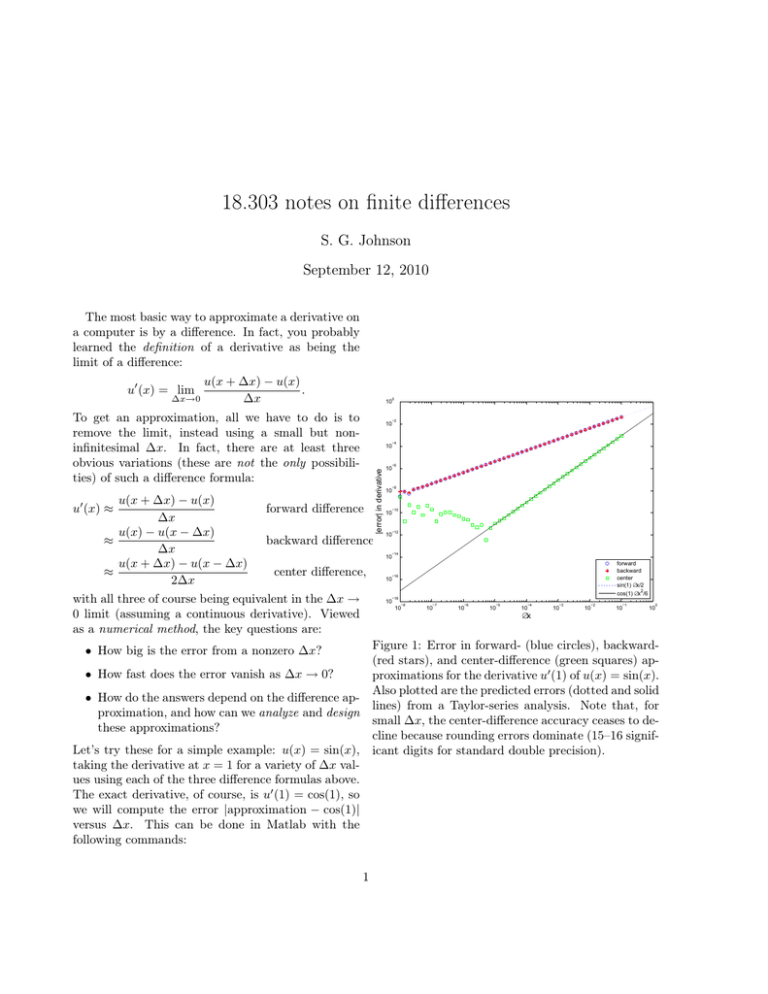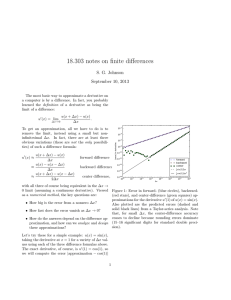18.303 notes on finite differences S. G. Johnson September 12, 2010
advertisement

18.303 notes on finite differences
S. G. Johnson
September 12, 2010
The most basic way to approximate a derivative on
a computer is by a difference. In fact, you probably
learned the definition of a derivative as being the
limit of a difference:
u(x + ∆x) − u(x)
.
∆x→0
∆x
u0 (x) = lim
0
10
To get an approximation, all we have to do is to
remove the limit, instead using a small but noninfinitesimal ∆x. In fact, there are at least three
obvious variations (these are not the only possibilities) of such a difference formula:
−2
10
−4
10
|error| in derivative
−6
10
−8
10
u(x + ∆x) − u(x)
u0 (x) ≈
forward difference
10
∆x
u(x) − u(x − ∆x)
10
≈
backward difference
∆x
10
forward
u(x + ∆x) − u(x − ∆x)
backward
≈
center difference,
center
10
2∆x
sin(1) ∆x/2
cos(1) ∆x /6
with all three of course being equivalent in the ∆x →
10
10
10
10
10
10
10
10
10
10
0 limit (assuming a continuous derivative). Viewed
∆x
as a numerical method, the key questions are:
Figure 1: Error in forward- (blue circles), backward• How big is the error from a nonzero ∆x?
(red stars), and center-difference (green squares) ap• How fast does the error vanish as ∆x → 0?
proximations for the derivative u0 (1) of u(x) = sin(x).
Also plotted are the predicted errors (dotted and solid
• How do the answers depend on the difference aplines) from a Taylor-series analysis. Note that, for
proximation, and how can we analyze and design
small ∆x, the center-difference accuracy ceases to dethese approximations?
cline because rounding errors dominate (15–16 signifLet’s try these for a simple example: u(x) = sin(x), icant digits for standard double precision).
taking the derivative at x = 1 for a variety of ∆x values using each of the three difference formulas above.
The exact derivative, of course, is u0 (1) = cos(1), so
we will compute the error |approximation − cos(1)|
versus ∆x. This can be done in Matlab with the
following commands:
−10
−12
−14
−16
2
−18
−8
1
−7
−6
−5
−4
−3
−2
−1
0
For the forward and backward differences, the error
in the difference approximation is dominated by the
u00 (x) term in the Taylor series, which leads to an
error that (for small ∆x) scales linearly with ∆x.
For the center -difference formula, however, the u00 (x)
term cancelled in u(x + ∆x) − u(x − ∆x), leaving us
with an error dominated by the u000 (x) term, which
scales as ∆x2 .
In fact, we can even quantitatively predict the error magnitude: it should be about sin(1)∆x/2 for
the forward and backward differences, and about
cos(1)∆x2 /6 for the center differences. Precisely
these predictions are shown as dotted and solid lines,
respectively, in Figure 1, and match the computed errors almost exactly, until rounding errors take over.
Of course, these are not the only possible difference
approximations. If the center difference is devised so
as to exactly cancel the u00 (x) term, why not also add
in additional terms to cancel the u000 (x) term? Precisely this strategy can be pursued to obtain higherorder difference approximations, at the cost of making the differences more expensive to compute [more
u(x) terms]. Besides computational expense, there
are several other considerations that can limit one in
practice. Most notably, practical PDE problems often contain discontinuities (e.g. think of heat flow or
waves with two or more materials), and in the face
of these discontinuities the Taylor-series approximation is no longer correct, breaking the prediction of
high-order accuracy in finite differences.
x = 1;
dx = logspace(-8,-1,50);
f = (sin(x+dx) - sin(x)) ./ dx;
b = (sin(x) - sin(x-dx)) ./ dx;
c = (sin(x+dx) - sin(x-dx)) ./ (2*dx);
loglog(dx, abs(cos(x) - [f;b;c]), ’o’)
legend(’forward’, ’backward’, ’center’)
xlabel(’{\Delta}x’)
ylabel(’|error| in derivative’)
The resulting plot, beautified a bit with a few additional tweaks beyond those above, is shown in Figure 1. The obvious conclusion is that the forwardand backward-difference approximations are about
the same, but that center differences are dramatically
more accurate—not only is the absolute value of the
error smaller for the center differences, but the rate
at which it goes to zero with ∆x is also qualitatively
faster. Since this is a log–log plot, a straight line corresponds to a power law, and the forward/backwarddifference errors shrink proportional to ∼ ∆x, while
the center-difference errors shrink proportional to
∼ ∆x2 ! For very small ∆x, the error appears to go
crazy—what you are seeing here is simply the effect
of roundoff errors, which take over at this point because the computer rounds every operation to about
15–16 decimal digits.
We can understand this completely by analyzing
the differences via Taylor expansions of u(x). Recall
that, for small ∆x, we have
u(x+∆x) ≈ u(x)+∆x u0 (x)+
∆x3 000
∆x2 00
u (x)+
u (x)+· · · .
2
3!
∆x2 00
∆x3 000
u (x)−
u (x)+· · · .
2
3!
If we plug this into the difference formulas, after some
algebra we find:
u(x−∆x) ≈ u(x)−∆x u0 (x)+
forward difference ≈ u0 (x)+
∆x2 000
∆x 00
u (x)+
u (x)+· · · ,
2
3!
backward difference ≈ u0 (x)−
∆x 00
∆x2 000
u (x)+
u (x)+· · · ,
2
3!
center difference ≈ u0 (x) +
∆x2 000
u (x) + · · · .
3!
2






